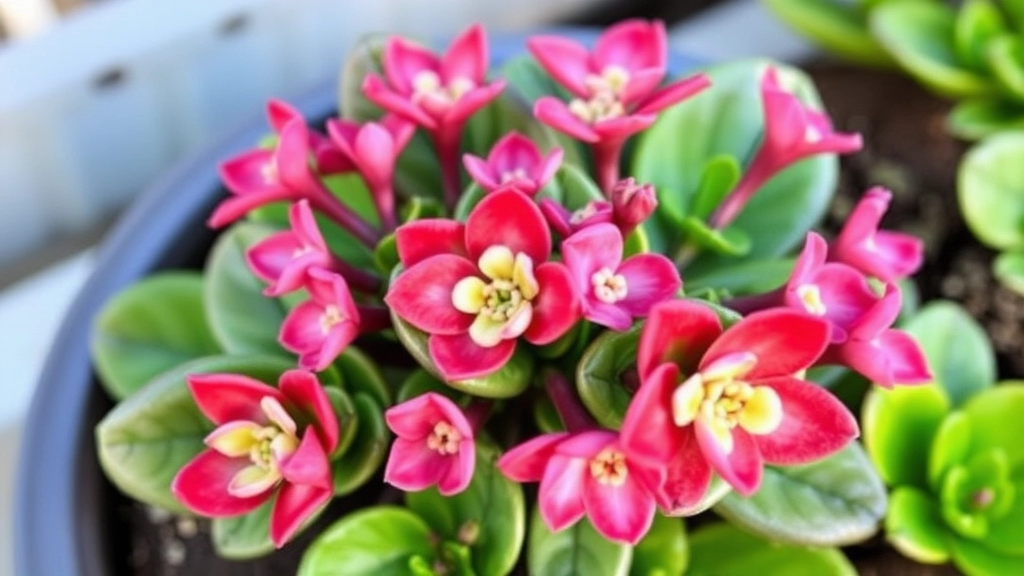Kalanchoe Not Flowering: Common Reasons and Solutions
If you’ve got a non flowering Kalanchoe, you’re not alone. Many of us have faced the frustration of waiting for those vibrant blooms, only to be met with stubborn greenery. Let’s dive into some common reasons why your Kalanchoe might not be flowering and how you can tweak your care routine to encourage those beautiful blooms.
Key Factors Affecting Flowering
- Lighting: Kalanchoes need plenty of bright, indirect light to thrive. If they’re not getting enough light, they might not bloom.
- Pruning: Regularly trimming your Kalanchoe can promote new growth and flowering.
- Dormancy Period: Your plant needs this rest to gather energy for the next blooming cycle.
Are you frustrated because your Kalanchoe isn’t blooming? You’re not alone. Many plant enthusiasts experience this issue, and it can be disheartening when you’re eagerly waiting for those vibrant flowers.
Several factors could be at play, preventing your Kalanchoe from showcasing its beauty. Let’s explore some of the most common reasons:
– **Insufficient Light**: Kalanchoe plants thrive in bright, indirect sunlight. If they’re not getting enough light, they may focus on growing foliage instead of flowers.
– **Overwatering**: This succulent is sensitive to water. If the soil remains soggy, it can lead to root rot, hindering blooming.
– **Nutrient Deficiency**: A lack of essential nutrients, particularly phosphorus, can impede flower development.
– **Improper Temperature**: Kalanchoe prefers temperatures between 18-24°C. Extreme cold or heat can stress the plant and affect its ability to bloom.
– **Lack of Dormancy**: These plants need a dormancy period to recharge. If they don’t get this rest, they may skip blooming altogether.
Understanding these common reasons can help you troubleshoot and get your Kalanchoe back on track. For more detailed guidance, check out these [solutions and tips](https://planthq.org/why-your-florist-kalanchoe-is-not-flowering-solutions-and-tips/) to ensure your plant blooms beautifully. Additionally, if you’re struggling with [dying leaves](https://planthq.org/why-are-my-kalanchoe-leaves-dying-causes-solutions/), it might be worth investigating further to keep your plant healthy and thriving.
How Lighting Affects Kalanchoe Flowering
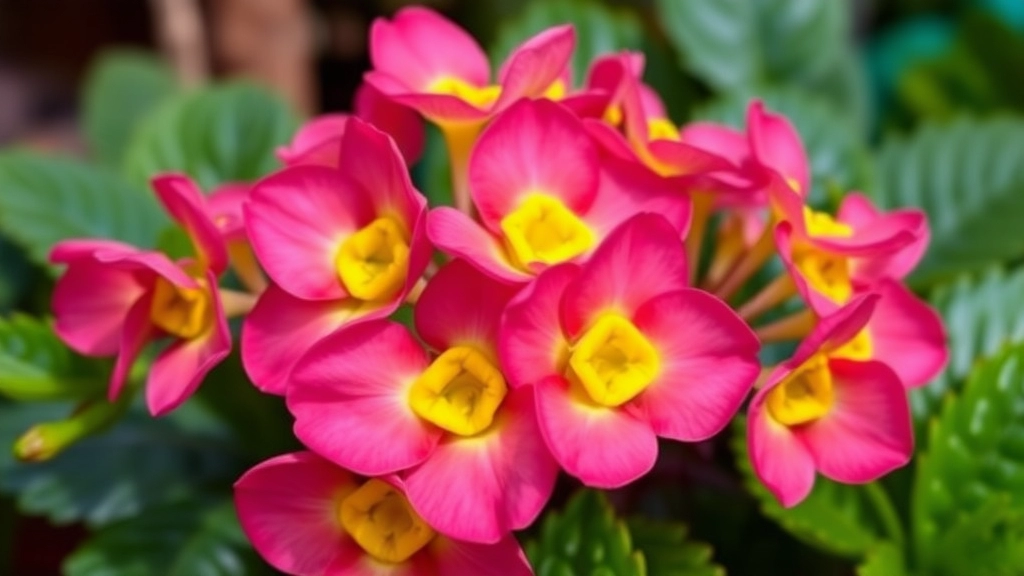
Ever wondered why your Kalanchoe isn’t blooming? Well, lighting plays a massive role in that. It’s one of those things that can really make or break your plant’s flowering potential.
The Importance of Light
Kalanchoes thrive in bright, indirect sunlight. If they don’t get enough light, they might just sulk and refuse to bloom. Here’s what you need to know:
- Direct Sunlight: Too much direct sun can scorch the leaves. A balance is key.
- Low Light: If your plant is in a dim corner, it might just give up on flowering altogether.
- Duration: Kalanchoes need around 12-14 hours of light daily during their growing season.
Tips for Optimal Lighting
Here are some easy tips to ensure your Kalanchoe gets the right amount of light:
- Location: Place it near a window with filtered light.
- Rotation: Rotate the pot every few weeks to ensure even light exposure.
- Seasonal Changes: Adjust its position as the seasons change; the sun’s angle shifts.
Signs of Light Stress
Keep an eye out for these signs that your Kalanchoe might not be getting enough light:
- Leggy Growth: If it’s stretching towards the light, it needs more.
- Yellowing Leaves: This can indicate stress from insufficient light.
The Role of Pruning in Encouraging Blooms
Many Kalanchoe owners often wonder why their plants are not blooming, despite their best efforts. One effective solution lies in the practice of pruning.
Pruning is not just about aesthetics; it plays a crucial role in promoting healthy blooms. By removing spent flowers and leggy growth, you can redirect the plant’s energy towards producing new buds. Here are some key points to consider:
- Timing is Everything: The best time to prune Kalanchoe is after the blooming period. This allows the plant to recover and prepare for the next flowering cycle.
- Cutting Techniques: Use clean, sharp scissors to make precise cuts. Aim to snip just above a leaf node to encourage new growth.
- Remove Dead or Dying Leaves: This not only improves the plant’s appearance but also prevents disease and pest issues that can hinder blooming.
- Encourage Bushier Growth: Pruning helps Kalanchoe develop a fuller shape, which can lead to more flowers.
- Regular Maintenance: A light trim every few months helps keep the plant healthy and encourages continuous blooming.
By integrating pruning into your care routine, you can significantly enhance your Kalanchoe’s flowering potential. For more detailed guidance, check out our ultimate guide to Kalanchoe Blossfeldiana hybrid care and learn how to grow Kalanchoe Blossfeldiana from seeds for a flourishing garden.
Watering Mistakes That Prevent Flowering
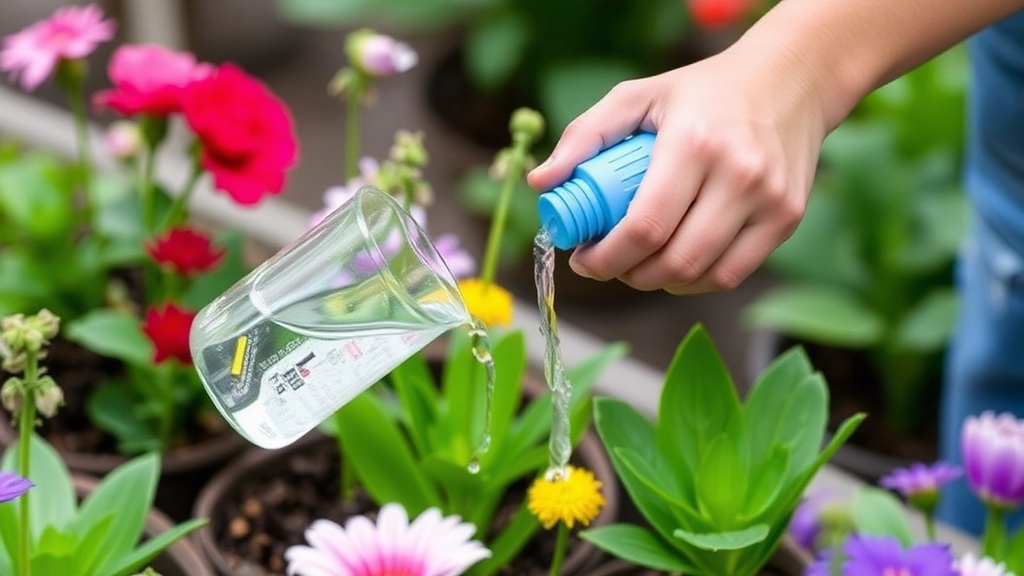
Have you ever wondered why your Kalanchoe isn’t blooming despite your best efforts? One common culprit could be watering mistakes.
Kalanchoe, like many succulents, thrives on a careful balance of moisture. Overwatering or underwatering can lead to stress, which often results in a lack of flowers. Here are some key points to consider:
- Overwatering: This is perhaps the most frequent mistake. Kalanchoe prefers to dry out between waterings. If the soil remains soggy, it can cause root rot, ultimately stunting growth and flowering.
- Underwatering: On the flip side, allowing the soil to dry out completely for extended periods can also hinder flowering. Kalanchoe needs consistent moisture, especially during its blooming season.
- Water Quality: Using chlorinated or hard water can affect your plant’s health. Opt for distilled or rainwater whenever possible.
- Watering Schedule: Establish a routine based on the season. In warmer months, you may need to water more frequently, while in winter, reduce the frequency to avoid waterlogged soil.
Understanding how to properly water your Kalanchoe is crucial for encouraging those vibrant blooms.
Importance of Dormancy Period for Flower Development
Are you wondering why your Kalanchoe isn’t blooming as expected? One critical aspect to consider is the plant’s dormancy period.
Dormancy is a natural phase in a Kalanchoe’s life cycle, typically occurring in late autumn to winter. During this time, the plant conserves energy and resources, preparing for the vibrant growth and blooming season ahead.
Why is this period so vital?
- Energy Conservation: The plant focuses on maintaining its health rather than producing flowers. This energy is essential for robust blooms later.
- Root Development: Dormancy allows the roots to strengthen and establish, which supports future flower production.
- Stress Management: A period of rest helps the plant recover from any stressors, such as pests or environmental changes, ensuring it can thrive when the blooming season arrives.
To encourage successful flowering, it’s crucial to respect this dormancy period. Here are some tips to manage it effectively:
- Reduce Watering: Cut back on watering during dormancy to mimic natural conditions.
- Limit Fertilization: Avoid fertilising during this time; it can stimulate growth instead of rest.
- Provide Adequate Light: While the plant needs less light, ensure it still receives some indirect sunlight to prevent it from becoming too weak.
For more detailed advice on Kalanchoe care, you can refer to our Ultimate Guide to Christmas Kalanchoe Care Tips and learn about the Kalanchoe Flowering Season to ensure your plants thrive year-round.
Fertilization Techniques to Boost Flower Production
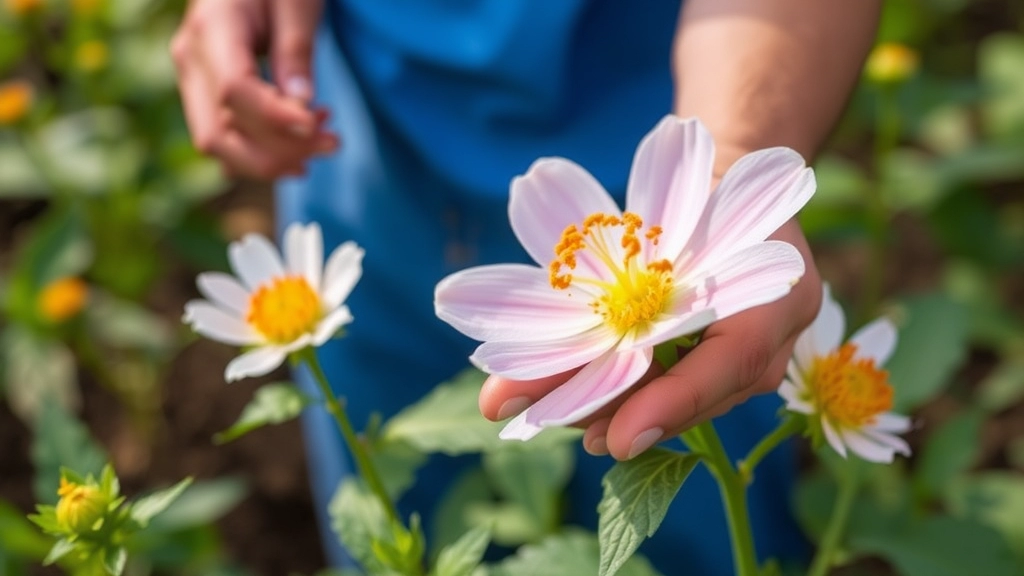
So, you’ve got your Kalanchoe all set up, but it’s just not blooming as you’d hoped. One of the key players in getting those beautiful flowers to pop is fertilization.
Why Fertilization Matters
Fertilizing your Kalanchoe isn’t just a nice-to-have; it’s essential for encouraging healthy blooms. Without the right nutrients, your plant can struggle to produce those vibrant flowers we all love.
Choosing the Right Fertilizer
When it comes to fertilizing, not all options are created equal. Here’s what I recommend:
- Balanced Fertilizer: Look for a balanced, water-soluble fertilizer with an NPK ratio of 15-30-15. This gives your plant the nutrients it needs for blooming.
- Low Nitrogen: Avoid high nitrogen fertilizers. They can promote leafy growth at the expense of flowers.
- Fertilizer Types: Consider using organic options like fish emulsion or a cactus mix. They’re gentle and effective.
Timing is Everything
Knowing when to fertilize can make a world of difference:
- Growing Season: Fertilize every 4-6 weeks during the growing season (spring and summer).
- Flowering Phase: If you want to give your Kalanchoe a little push, fertilize just before it’s set to bloom.
Application Tips
Here are some easy steps to follow:
- Dilute the Fertilizer: Always dilute your fertilizer to half the recommended strength.
- Water Beforehand: Water your plant a day before applying fertilizer to prevent root burn.
- Even Distribution: Apply the fertilizer evenly around the base of the plant, avoiding the leaves.
Signs of Over-Fertilization
Keep an eye out for these signs:
- Yellowing Leaves: This can indicate too much fertilizer.
- Leaf Burn: Brown tips are a clear signal to back off.
By following these fertilization techniques, you can set your Kalanchoe up for success and encourage those stunning blooms.
Have you noticed your Kalanchoe struggling to bloom despite your best efforts? It could be due to diseases or pests lurking in the shadows. These unwanted guests can significantly hinder the flowering process, leaving you frustrated.
### Common Pests Affecting Kalanchoe
– **Aphids**: These tiny insects suck sap from the plant, leading to stunted growth and fewer flowers.
– **Mealybugs**: Recognizable by their white, cottony appearance, they can weaken the plant and cause leaf drop.
– **Spider Mites**: These pests thrive in dry conditions and can create fine webs on your Kalanchoe, leading to yellowing leaves.
– **Scale Insects**: They appear as small, brown bumps on stems and leaves, sucking the plant’s vital nutrients.
### Identifying Diseases
– **Root Rot**: Overwatering can lead to root rot, causing wilting and poor flowering.
– **Powdery Mildew**: This fungal disease manifests as a white powder on leaves, hindering photosynthesis.
– **Leaf Spot**: Dark spots on leaves can indicate fungal infections, affecting overall plant health.
### Effective Management Strategies
– **Regular Inspections**: Check your Kalanchoe weekly for any signs of pests or diseases.
– **Natural Remedies**: Use insecticidal soap or neem oil to treat infestations without harsh chemicals.
– **Proper Watering**: Ensure you’re not overwatering to prevent root rot.
– **Good Air Circulation**: Keeping your plants spaced out helps reduce humidity and the risk of fungal diseases.
For more detailed guidance on how to address these issues, you might find our [Ultimate Guide to Flowering Kalanchoe Care Tips for Blooming](https://planthq.org/ultimate-guide-to-flowering-kalanchoe-care-tips-for-blooming/) helpful. Additionally, understanding the [Causes and Solutions for Drooping Kalanchoe Leaves](https://planthq.org/how-to-fix-drooping-kalanchoe-leaves-causes-and-solutions/) can provide further insights into maintaining healthy blooms.
Tips to “Force” Your Kalanchoe to Flower
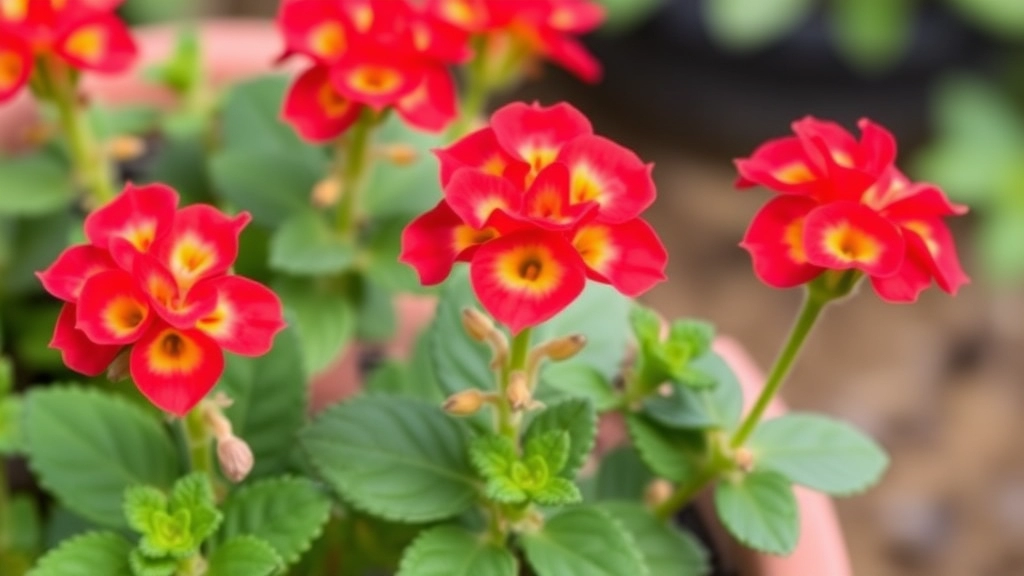
So, you’ve done everything right, but your Kalanchoe still isn’t blooming? I totally get it. It can be frustrating when you’re eager to see those vibrant flowers. But don’t worry; there are some nifty tricks you can use to give your plant that extra nudge.
1. Adjust the Lighting
Kalanchoes love bright light but can be a bit picky about it. To encourage blooming:
- Provide 12-14 hours of bright, indirect sunlight daily.
- Avoid direct sunlight for too long, as it can scorch the leaves.
- If you can, use a grow light during the shorter days of winter.
2. Control the Temperature
These little beauties thrive in warmth. Keep your Kalanchoe in a spot where:
- Daytime temperatures are around 20-24°C (68-75°F).
- Nighttime temperatures drop to about 15-18°C (59-65°F).
- Avoid cold drafts and sudden temperature changes.
3. Prune Wisely
Pruning isn’t just for looks. It can actually stimulate new growth and blooms. Here’s how:
- Trim back leggy stems after blooming to promote bushier growth.
- Remove spent flowers to encourage the plant to produce more.
4. Stress It Out a Bit
Sometimes, a little stress can do wonders. Consider:
- Reducing watering slightly before the blooming season.
- Keeping it a bit pot-bound can also encourage flowering, so don’t rush to repot.
5. Fertilize with Purpose
Feeding your Kalanchoe right can make a world of difference. Try:
- Using a balanced fertiliser every 4-6 weeks during the growing season.
- Switching to a high-phosphorus formula (like 10-30-20) a month before you expect blooms.
6. Mimic Seasonal Changes
Kalanchoes need a dormancy period. To mimic this:
- Reduce watering and stop fertilising for about six weeks during the winter.
- This signals to your plant that it’s time to rest before blooming.
Seasonal Care to Maintain Healthy Blooms Year-Round
Are you wondering how to keep your Kalanchoe blooming beautifully throughout the year?
Seasonal care is crucial for ensuring that your Kalanchoe not only survives but thrives, producing vibrant flowers consistently.
Understanding Seasonal Needs:
- Spring:
- As the days get longer, this is the ideal time for repotting.
- Choose a pot with good drainage and fresh soil.
- Begin fertilising every two weeks with a balanced fertiliser.
- Summer:
- Keep your Kalanchoe in bright, indirect light.
- Water more frequently, allowing the soil to dry out between waterings.
- Consider moving it outdoors for some natural sunlight.
- Autumn:
- Gradually reduce watering as the plant prepares for dormancy.
- Maintain bright light to encourage flower buds.
- Cut back on fertilisation to prepare for the winter months.
- Winter:
- This is the dormancy period.
- Water sparingly; over-watering can lead to root rot.
- Ensure your Kalanchoe receives enough light, as this will set the stage for blooming in spring.
Key Tips for Seasonal Care:
- Monitor Temperature:
- Keep your Kalanchoe in a room where temperatures range between 15-25°C. For more detailed information, check out the ideal temperature for Kalanchoe Blossfeldiana growth.
- Humidity Levels:
- Kalanchoe prefers low humidity; avoid placing it near humidifiers or in bathrooms.
- Pest Control:
- Regularly check for pests, especially during warmer months. Learn how to handle common issues in our Kalanchoe Tomentosa care guide.
- Use neem oil or insecticidal soap if necessary.
FAQs on Non-Flowering Kalanchoe
Why is my Kalanchoe not blooming?
Several factors can prevent your Kalanchoe from blooming, including insufficient light, improper watering, and lack of fertilization. Ensuring your plant receives the right care can significantly improve its chances of flowering.
How important is lighting for Kalanchoe flowering?
Lighting is crucial for Kalanchoe flowering. These plants thrive in bright, indirect sunlight. Insufficient light can cause them to stop blooming, while too much direct sunlight can scorch the leaves.
What are the signs that my Kalanchoe is not getting enough light?
Signs of insufficient light include leggy growth, where the plant stretches towards the light, and yellowing leaves, indicating stress.
How should I water my Kalanchoe to encourage flowering?
Kalanchoes need a balance of moisture. Overwatering can lead to root rot, while underwatering can stress the plant. It’s best to let the soil dry out between waterings and use distilled or rainwater to avoid chlorinated or hard water.
What type of fertilizer should I use for my Kalanchoe?
A balanced, water-soluble fertilizer with an NPK ratio of 15-30-15 is ideal. Avoid high nitrogen fertilizers, as they promote leafy growth at the expense of flowers. Organic options like fish emulsion or a cactus mix are also effective.
When is the best time to fertilize my Kalanchoe?
Fertilize every 4-6 weeks during the growing season (spring and summer). You can also fertilize just before the plant is set to bloom to give it an extra push.
How can I “force” my Kalanchoe to flower?
To encourage blooming, you can adjust lighting to provide 12-14 hours of bright, indirect sunlight daily, control temperature to maintain warmth, prune wisely, slightly reduce watering before the blooming season, and use a high-phosphorus fertilizer a month before you expect blooms.
What are the signs of over-fertilization in Kalanchoe?
Signs of over-fertilization include yellowing leaves and leaf burn, indicated by brown tips. If you notice these signs, reduce the amount of fertilizer you are using.
Can pruning help my Kalanchoe bloom?
Yes, pruning can stimulate new growth and blooms. Trim back leggy stems after blooming to promote bushier growth and remove spent flowers to encourage the plant to produce more.
Does my Kalanchoe need a dormancy period to bloom?
Yes, Kalanchoes benefit from a dormancy period. Reduce watering and stop fertilizing for about six weeks during the winter to signal to your plant that it’s time to rest before blooming.
References
-
Why Isn’t My Kalanchoe Blooming?
-
Kalanchoe Plant Care
-
Kalanchoe: How to Grow and Care for Kalanchoe
